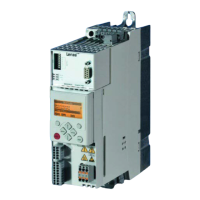Firmware ≤ 11.00 - DMS 8.0 EN - 10/2011 L 237
8400 StateLine C | Reference manual
Motor control (MCTRL)
Monitoring
5.12.4 Brake resistor monitoring (I2xt)
Due to the converted braking power, the brake resistor is thermally stressed and can even
be thermally destroyed by excessive braking power.
The monitoring of the I
2
xt utilisation of the controller serves to protect the brake resistor.
It acts in proportion to the converted braking power.
If the I
2
xt utilisation reaches the switch-off threshold set in C00572:
– The error response set in C00574
will take place.
–The "OC12: I2xt brake resistor overload
" error message is entered into the logbook.
–The bMctrlBrakeChopper status output of the LS_DeviceMonitor
system block will be
set to TRUE.
If the system is dimensioned correctly, the monitoring should not be activated. If
individual pieces of rated data of the actually connected brake resistor are not known,
they have to be identified.
If the DC-bus voltage exceeds the overvoltage threshold due to a braking energy that is
too high, the monitoring for overvoltage in the DC bus is activated ("OU: DC-bus
overvoltage" error message).
Apart from the threshold of the I
2
xt utilisation that can be set in C00572, there is the
switching threshold of the brake transistor which results from the mains voltage
(C00173
) and the reduced brake chopper threshold (C00174).
Danger!
In the Lenze setting (C00574 = "0: No Reaction") the response of the monitoring
function does not
stop the braking process!
In particular for applications such as hoists or applications with a DC-bus
connection, it must be checked if a stopping of the braking process due to a
setting of C00574
= "1: Fault" is permissible.
Stop!
Implement appropriate protective measures against thermal overload of the
brake resistor!
Examples:
• Parameterisation of an error response in C00574 and evaluation of the
parameterised error message within the application or the machine control
system.
• Interruption of the mains supply by means of the temperature contact at the
brake resistor and a simultaneous activation of the mechanical brake.

